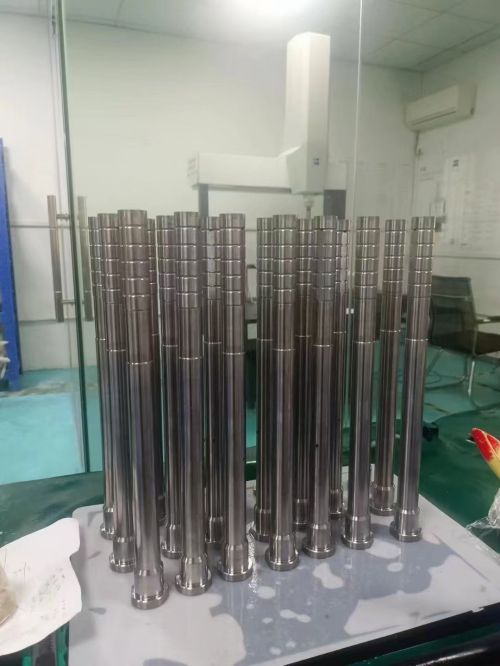How to Extend the Lifespan of Mold Insert Pins?
Mold insert pins are a common component in the mold industry, playing a crucial role in ensuring the proper ejection of parts with circular through-holes or blind holes. These metal ejection devices consist of two main parts: the mold insert pin (also known as an ejector sleeve) and the inner core pin. The mold insert pin is sleeved over the inner core pin, allowing it to move up and down. The inner core pin is fixed to the base plate of the mold, while the mold insert pin is attached to the ejector plate. During ejection, the mold insert pin moves upward with the ejector plate, while the inner core pin remains stationary, as it is fixed to the mold base plate. This motion allows the mold insert pin to push the molded product off the inner core pin and out of the mold.
Given the critical role that mold insert pins play in the injection molding process, it is essential to extend their lifespan to ensure efficient and cost-effective production. Below, we outline some key strategies for prolonging the life of mold insert pins, as recommended by experts at a leading mold insert pin factory.

1. Selecting the Right Mold Insert Pin Material
The choice of material is fundamental in determining the strength, toughness, and wear resistance of mold insert pins. Different applications require mold insert pins made from materials with varying properties. For instance, some mold insert pins may need to withstand high temperatures or corrosive environments, while others may require exceptional hardness to resist wear.
Using high-quality materials under appropriate conditions can significantly enhance the durability of mold insert pins. For example, pins made from premium tool steels, such as H13 or SKD61, are known for their excellent toughness and heat resistance, making them ideal for demanding applications. Additionally, applying surface treatments like nitriding or TiN (Titanium Nitride) coating can further improve the wear resistance and lifespan of the mold insert pins. Thus, to increase the durability of mold insert pins, it is crucial to select materials that are best suited to the specific requirements of your injection molding process.

2. Improving the Design of Injection Molds
The design of the injection mold is a critical factor in determining the longevity of mold insert pins. A well-designed mold can minimize stress on the insert pins, reducing wear and tear and prolonging their lifespan. Several design considerations can help achieve this:
Minimizing the Length of Small Protrusions: When designing molds with small holes or delicate features, it is essential to reduce the length of protruding elements, such as the mold insert pins. Shorter pins are less likely to bend or break under pressure, which enhances their durability.
Using Guide Sleeves for Protection: In cases where mold insert pins are particularly thin or fragile, it is advisable to use guide sleeves to provide additional support. These sleeves help maintain the alignment of the mold insert pins during operation, reducing the risk of damage.
Optimizing Clearance: The clearance between the mold insert pin and the mold cavity should be carefully calculated. If the clearance is too small, it can lead to excessive friction and wear, significantly shortening the lifespan of the insert pins. Conversely, slightly increasing the clearance, within acceptable tolerances, can greatly improve the durability of the pins. In fact, in some cases, this adjustment can extend the lifespan of mold insert pins by several times.
By addressing these design factors, manufacturers can ensure that their injection molds are optimized for longevity, thereby extending the service life of mold insert pins and reducing the frequency of replacements.

3. Proper Maintenance and Handling
Regular maintenance and proper handling are essential for maximizing the lifespan of mold insert pins. Even the highest-quality pins can suffer from premature wear if they are not maintained correctly. Some key maintenance practices include:
Regular Inspection: Frequent inspection of mold insert pins for signs of wear, such as scratches, deformation, or chipping, can help identify issues before they lead to failure. Early detection allows for timely repairs or replacements, preventing more significant damage to the mold or the finished products.
Lubrication: Adequate lubrication is critical to reducing friction between the mold insert pin and the mold cavity. Using the correct type and amount of lubricant can significantly extend the lifespan of the insert pins by preventing excessive wear.
Proper Installation: Ensuring that mold insert pins are correctly installed in the mold is also crucial. Misalignment or improper seating can lead to uneven wear or even breakage. Following the manufacturer’s guidelines for installation and using the appropriate mold insert pin retainers can help avoid these issues.
Conclusion:
Extending the lifespan of mold insert pins is a multifaceted process that involves careful material selection, thoughtful mold design, and diligent maintenance. By choosing the right materials, improving mold design, and adhering to best practices for maintenance and handling, manufacturers can significantly increase the durability of their mold insert pins. This not only enhances the efficiency and cost-effectiveness of the injection molding process but also contributes to the overall quality of the finished products. By implementing these strategies, manufacturers can ensure that their mold insert pins provide reliable, long-term performance, ultimately leading to greater productivity and reduced operational costs.
mold insert pin mold insert pin retainers mold insert pin factory


